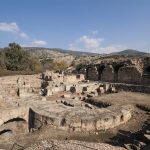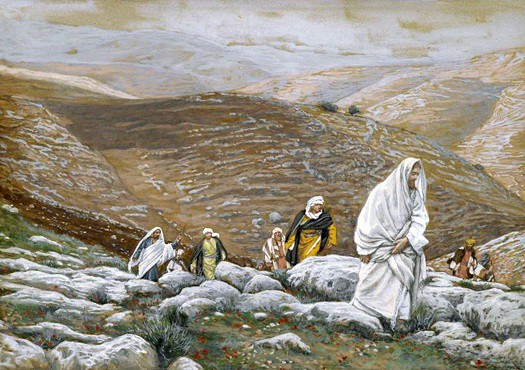51 When the days drew near for him to be taken up, he set his face to go to Jerusalem. 52 And he sent messengers ahead of him. On their way they entered a village of the Samaritans to make ready for him; 53 but they did not receive him, because his face was set toward Jerusalem. 54 When his disciples James and John saw it, they said, “Lord, do you want us to command fire to come down from heaven and consume them?” 55 But he turned and rebuked them. 56 Then they went on to another village. [Luke 9:51-56, NRSV]
(L) Greco-Roman times, Caesarea Philippi; (R) James Tissot, Jesus Goes up to Jerusalem.
Caesarea Philippi is literally “Philip’s Caesarea”, Philip being the half-brother of Herod Agrippa. Now nearly uninhabited, Caesarea is an archaeological site in the Golan Heights. In passing, we ought to mention that as a geopolitical region, the Golan Heights is the area captured from Syria and occupied by Israel during the 1967 Six-Day War, a territory which Israel effectively annexed in 1981. This region includes the western two-thirds of the geological Golan Heights, as well as the Israeli-occupied part of Mount Hermon. Our half-day trip to the region of the Golan Heights was for the most part a waste of time, unless anybody was actually interested in learning about wars in the region, or in enjoying the view of a forlorn wasteland dotted by rusted tanks. A lone Arab fruit vendor capitalized on a rare opportunity to fleece tourists, charging one American dollar for a banana.
Back to Caesarea Philippi, it was originally called Paneas, but later changed to Caesarea Paneas, from the Hellenistic period after its association with the god Pan, a name that mutated to Banias. During the Greco-Roman times, Caesarea Philippi was a city located near the ancient city of Dan, in the northern part of Israel, by Mount Hermon and the Jordan River.
Where the Banias stream leads to the cliff area, we find a very unique place. We see a rocky face that rises 100 feet and runs 500 feet wide, with a foreboding cave in the middle where temple ruins lie strewn about. It was here that Herod the Great built the Temple of Augustus (Augusteum) in 19 B.C. to honor his Caesar. The temple sat in front of the cave that was believed to be the gateway to the underworld, and that was where the Greek god Pan was supposed to live.
Of the three temples Herod constructed in Israel to honor Caesar Augustus, he willed this temple at Caesarea Philippi and the whole region to his younger son Philip when he died in 4 B.C.. Philip then built this city up to be his capital and to honor his Caesar, Tiberius.
The fact is, the entire area was identified as a sin city, so much so that rabbis forbade a good Jew to come here.
The Jewish historian, Josephus, has records of the location. He refers to the cave as dark, descending abruptly to a great depth, and containing a mighty quantity of water, which is immovable. Interestingly, he points out that “the fountains of Jordan rise at the roots of this cavity outwardly; and, as some think, this is the utmost origin of Jordan.”
Today, while Caesarea Philippi is a site of archeological importance, visitors are usually led to the Banias Nature Reserve, which really is of no relevance to a Holy Land Pilgrimage, except for the fact that at the edge of the nature reserve is the archeological ruins of the temple and the cave we have just referred to. Our half day trip to this nature reserve was to that extent a waste of time.
Reflection:
Our interest in Caesarea Philippi, then, lies in its Gospel association (Matthew 16:13-20, Mark 8:27–30 and Luke 9:18–20), concerning which three points stand out for us.
1. Jesus’ Identity Revealed at Caesarea Philippi
In the Synoptic Gospels, towards the end of his three-year public ministry as an itinerant preacher around Galilee, Jesus went north to the area near the city of Caesarea Philippi, but without entering the city itself. What happened here marked the turning point in the Gospel narratives. Jesus, while in this area, asked his closest disciples who they thought he was. In the Gospel of Mark, Peter confessed Jesus as “the Christ” which is Messiah in Jewish (Mark 8:29), to which Matthew added “the Son of the living God” (Matthew 16:16).
This proclamation of Jesus as Christ at Caesarea Philippi is fundamental to Christology. Peter’s Confession and Jesus’ acceptance of the title “Messiah” form a definitive statement in the New Testament narrative regarding the identity of Jesus Christ. In this narrative, Jesus not only accepts the titles “Christ” and “Son of God”, but declares the proclamation a divine revelation and that his Father in Heaven had revealed it to Peter. What we have in the Gospels, therefore, is an unequivocal declaration by Jesus himself to be both Christ and the Son of God.
So important is this revelation for Matthew, that the evangelist spot-lights a charge which Jesus gave to Peter:
- “And I tell you, you are Peter, and on this rock I will build my church, and the power of death shall not prevail against it. I will give you the keys of the kingdom of heaven…” (Matthew 16:18-19).
Here then, is where we locate the Gospel references on where Jesus selected Peter as the leader of the Apostles – the first amongst equals – and on the supremacy of the Church of Christ over Hades.
- The Roman Catholic Church takes this scripture as authoritative for the Petrine primacy, but most other Christian denominations, even as they agree that the statement applies to Peter, diverge on their interpretations of what happens after Peter.
- Biblically speaking, Jesus’ promise about his Church’s supremacy over Hades now appears all the more poignant: the gates of Hades (or “the power of death”) will not overcome this Church. How perfect that one of the most sinful places in Israel was where Jesus revealed himself to be the Messiah of the true God of Israel.
So important is this proclamation of Jesus’ identity that it marks the turning point in the entire narrative of the Synoptic Gospels. From now on, as Luke puts it best, Jesus resolutely set his face to Jerusalem (Luke 9:51), and he began to teach his disciples about his impending suffering and death in Jerusalem, the city of the Temple of the Jews, the city of David and Solomon.
All three of the Synoptics end the account with Jesus telling the disciples not to reveal that he was the Messiah to anyone, a statement which is consistent with the principle of the “Messianic Secret” most conspicuously emphasized in the Gospel of Mark.
2. Going UP to Jerusalem
From Caesarea Philippi, Jesus and his disciples traveled south through Galilee upwards to Jerusalem.
This journey “up” to Jerusalem had two dimensions.
First, Jesus made a physical ascent from Galilee, which is 700 feet below sea level, to Jerusalem which is 3,000 feet above sea level.
Second, this physical ascent, as Pope Benedict XVI points out, is accompanied by a spiritual ascent to the Temple, then to the cross, and finally to the Father. In this journey, Jesus’ external footsteps were accompanied by his profound interior journey guided by the Spirit. It always involved his interior spirit of loving God with all his mind, heart, soul and energy, and loving humanity as himself. And that is precisely what our pilgrimage ought essentially be.
Along the journey towards Jerusalem, Jesus performed many things and taught the disciples important lessons on discipleship. For a fruitful personal or communal retreat on discipleship, we recommend reflections on Mark 8-10. It is a rich and excellent text.
3. Mark 8-10
By the end of his Galilean ministry, Jesus had met with utter misunderstanding – by his family, the religious leaders, and even his own disciples. The Pharisees had called him a blasphemer, the scribes had accused him of having the power of the devil, and fearing him, the herdsmen of Garasenes had asked him to leave their territory (see Mark 2:7; 3:22; 5:1-20). Though many followers regarded Jesus as a powerful teacher or one who could work miracles (see Mark 1:40; 5:23, 28; 6:56), even those closest to him were slow to understand him (see Mark 1:22; 4:41; 6:2, 51–52). This confusion regarding Jesus’ identity can indicate a “spiritual blindness,” sometimes seen in the Gospel of Mark, among those whom the Savior taught.
From the turning point at Caesarea Philippi, the rest of Mark Chapters 8–10 present, amongst other events, Jesus’ three prophecies of his impending suffering, death, and resurrection in Jerusalem (see Mark 8:31–33; 9:30–32; 10:32–34). After each foretelling, Jesus needed to correct the wrong “vision” of his disciples by teaching them more about their own role. Just as Jesus Christ’s mission involved humility, suffering, and death, the missions of his disciples would involve taking up their crosses, losing their lives for his sake, being humble and becoming servants of all (see Mark 8:34–38; 9:32–37, 43–48; 10:35–45). Before anybody else, disciples of Jesus must learn that when we constantly strive to save our status and position in this world, we lose a larger life. It is a simple but all-important feature of consciousness; putting all our energy into gaining the whole world is a misplaced focus, not a profitable enterprise. In church as in society, we must deny this tendency to center everything on this small sense of ourselves. The alternative vision offered by Jesus is the far more valuable life of God’s love. Disciples who learn from Jesus to center themselves in God’s love will follow the impulses of that love.
- They become willing servants of love’s basic energy to serve the well-being of others;
- They seek not greatness, but to become small;
- Instead of lording it over others, they grow in humble service;
- They become deeply offensive to rulers of this world who will make them suffer;
- But refusing to shirk from their duty to follow Jesus, they will take up this cross as the inevitable price of following Jesus in a loveless world; and
- In so following Jesus’ way, they may be shamed and shunned, but they know they are valuing the things of God.
The events and teachings recorded in chapters 8–10 are framed by two healings of the blind, one unnamed at the front, and the other called Bartimaeus at the end. Clearly, Mark intends to show that:
- disciples of Jesus need to overcome human blindness and gradually come to see him as the Messiah;
- then they will see for themselves their spiritual enemies through his suffering and death; and
- as worthy disciples, learn to walk behind him, following his humble and sacrificial way towards peace and eternal life through the cross.
All this, the Synoptic Gospels point out in one voice, is taught by Jesus. It began in earnest at Caeserea Philippi when Jesus turned and set his face towards Jerusalem and the cross.
Copyright © Dr. Jeffrey & Angie Goh, February 2019. All rights reserved.
You are most welcome to respond to this post. Email your comments to jeffangiegoh@gmail.com. You can also be dialogue partners in this Ephphatha Coffee-Corner Ministry by sending us questions for discussion.


